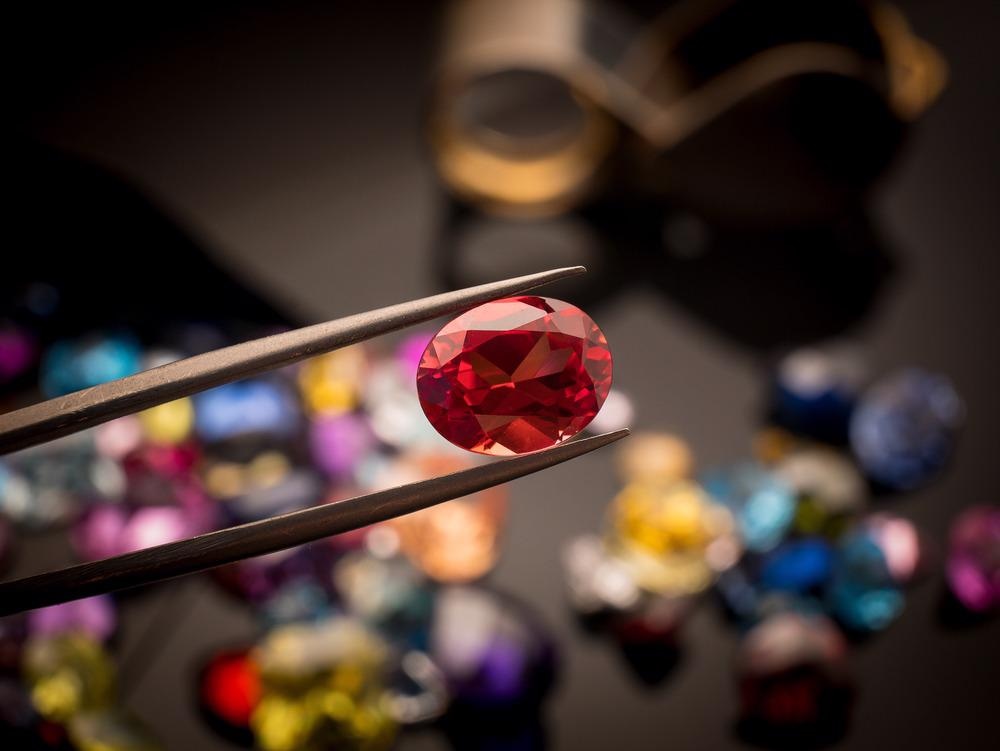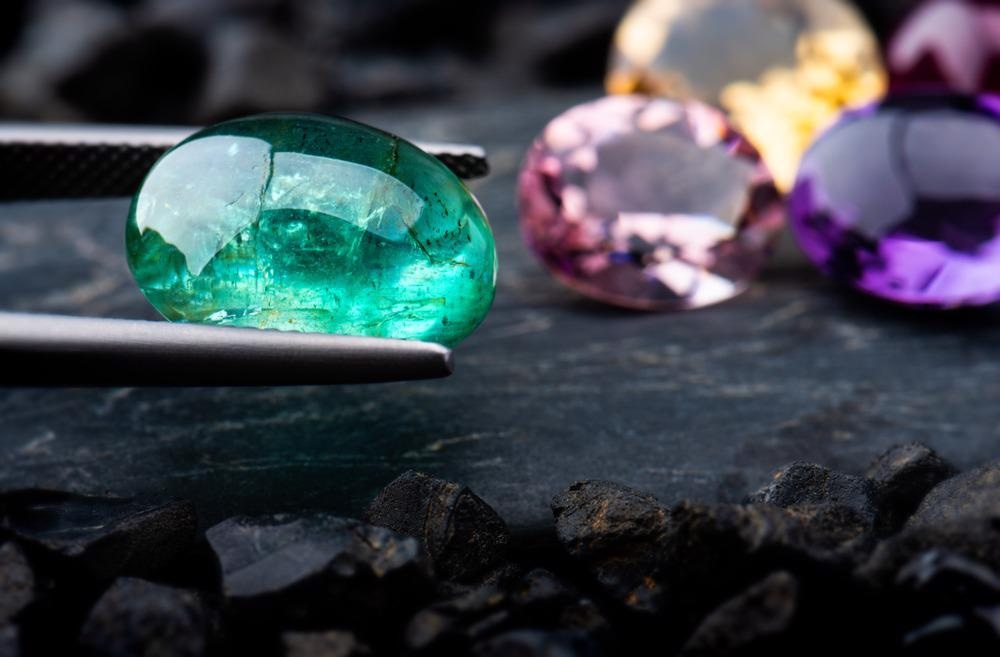Identifying gemstones is not a trivial task. While properties such as color and transparency can help with identification, gemstones such as rubies, spinels, and garnets can be difficult to distinguish from these properties alone.

Image Credit: Akkaradet Bangchun/Shutterstock.com
Many gemologists will supplement their visual inspection of gemstones with a series of optical techniques, including measurements of refractive index, birefringence, and even spectroscopic measurements. For example, due to the arrangement of the atoms in the underlying crystal structure, most garnets have little to no birefringence.
This is not the case for rubies, which have much higher degrees of birefringence and give rise to their distinct pleochroism—this means multiple colors will appear in the stone at a given viewing angle.
What defines a gemstone is the chemical composition, the crystal lattice—how the individual atoms are arranged in the atomic framework of the gemstone—and sometimes also the habit or the typical location where they are found. Identifying the chemical composition and bonding arrangements requires analytical tools that are sensitive to the presence of particular elements and their local bonding environments.
Raman Spectroscopy
One spectroscopic tool that is sensitive to chemical environments, bond strengths, and, indirectly, to elemental information is Raman spectroscopy. Raman spectroscopy can be used to recover quantitative and qualitative information on solid and molecular species.
In the jewelry industry, Raman spectroscopy can provide greater confidence in the identification of gemstones. It is a non-invasive technique that does not require any sample preparation and can be used both on freestanding or mounted gems, making it highly flexible for gemstone analysis.
In a Raman experiment, the sample of interest is excited with a given wavelength of light, often using a laser source. The inherently weak nature of Raman signals due to the inefficiency of the scattering process involved means that often relatively high power sources are required.

Image Credit: NPDstock/Shutterstock.com
Once the sample has been excited, the scattered radiation is detected using a spectrometer and the relative energy shift of the observed peaks is used to calculate the frequencies of different vibrational modes in the sample.
Once the Raman spectrum has been reconstructed, the peak shapes and positions can be used to identify which atoms are likely to be present in the sample.
This is because the frequency of a vibrational mode is dependent on the masses of the atoms involves and the strength of the bonding between them. In different crystal lattice structures, the bond strengths between the atoms in various positions of the lattice can also vary, so information about the possible crystal structure can also be retrieved.
Applications
As well as gemstone identification, Raman spectroscopy is a powerful forensic tool for the investigation of fake stones. Raman microscopy that provides spatially resolved Raman spectra is particularly good for the investigation of defects or potential fakes, as it can identify regions where stones have been ‘treated’ with other chemical species to enhance their perceived value.
Many of these treatments are nearly impossible to detect by eye, and while any treatment a gemstone has undergone should be declared, they often are not in an attempt to claim a higher price. Raman microscopy can identify regions where dopants have been introduced and also help pick apart their chemical structure and identity.
What helps enhance the certainty of identification with Raman is a large number of peaks in the spectrum. A molecules will have 3N-6 vibrational modes, where N is the number of atoms, and while not all of these may be Raman active, a pattern of frequencies can be matched to give a ‘fingerprint’ of the particular gemstone.
Raman in Art
Recent work has been developing more portable handheld devices that make it possible to investigate gemstones in situ as well as the use of databases of Raman frequencies of minerals to aid in positive identification.
With Raman spectroscopy methods able to differentiate between natural or treated gemstones as well as providing reliable, positive identification of gemstone types, there are now relatively straightforward procedures for applying Raman spectroscopy for analysis even on lower-powered handheld instruments.
Such developments are particularly beneficial for art history applications as many objects are too fragile to be moved to the laboratory so must be measured in situ.
One of the challenges with Raman spectroscopy is overcoming the fluorescence background that can make it impossible to see the vibrational modes of the species of interest. Choosing shifting excitation wavelengths may be one way of overcoming this while not compromising on the reduced scattering signal from longer wavelength excitation.
This may be particularly useful for art analysis where there are likely to be trace contaminants of pigments and other fluorescent species present on the gemstone.
References and Further Reading
Shigley, J. E. (2008). A review of current challenges for the identification of gemstones. Geologija, (64). http://mokslozurnalai.lmaleidykla.lt/publ/1392-110X/2008/4/227-236.pdf
Antao, S. (2013). The mystery of birefringent garnet: Is the symmetry lower than cubic? Powder Diffraction, 28(4), 281-288. doi:10.1017/S0885715613000523
Bersani, D., & Lottici, P. P. (2010). Applications of Raman spectroscopy to gemology. Anal Bioanal Chem, 397, 2631–2646. https://doi.org/10.1007/s00216-010-3700-1
Elboux, D., Izumi, C. M. S., & Faria, D. L. A. De. (2016). Fake turquoises investigated by Raman microscopy. Forensic Science International, 262, 196–200. https://doi.org/10.1016/j.forsciint.2016.03.041
Culka, A., & Jehlicka, J. (2019). Identification of gemstones using portable sequentially shifted excitaiton Raman spectrometer and RRUFF online database: A proof of concept study. Eur. Phys. J. Plus, 134, 130 https://link.springer.com/article/10.1140/epjp/i2019-12596-y
Disclaimer: The views expressed here are those of the author expressed in their private capacity and do not necessarily represent the views of AZoM.com Limited T/A AZoNetwork the owner and operator of this website. This disclaimer forms part of the Terms and conditions of use of this website.